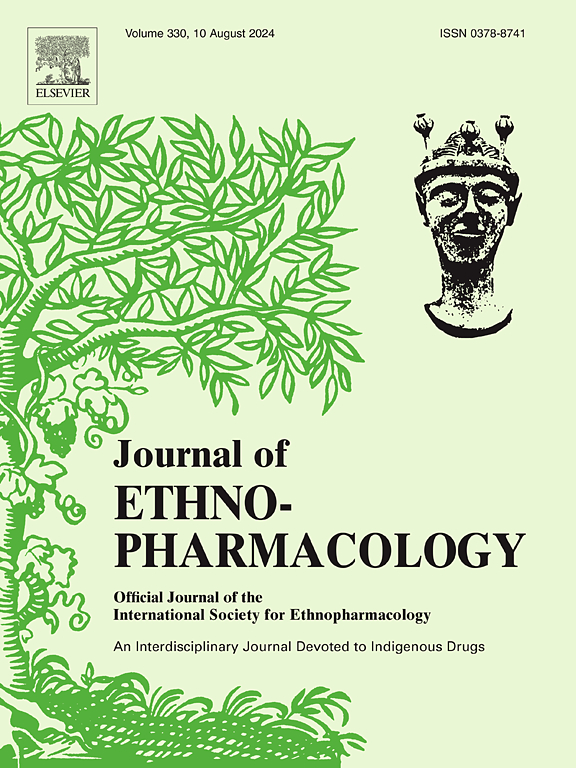Overview of oyster polysaccharide extraction process and pharmacological activity studies
IF 4.8
2区 医学
Q1 CHEMISTRY, MEDICINAL
引用次数: 0
Abstract
Ethnopharmacologic relevance
Oysters, also known as oysters or sea oysters, are a type of marine creatures with a long history of medicinal use and rich nutritional value. Oyster shells and oyster meat contain a variety of active substances that can be used as medicinal herbs. Among them, oyster polysaccharides (OPSs) is one of the main active substances, which has antioxidant, hepatoprotective, immunomodulatory, antitumor, hypoglycemic, and intestinal protective effects. OPSs have received increasing attention for their significant health and medicinal benefits and are considered a valuable resource in the field of ethnopharmacology.
Aim of the study
This overview aims to fill this gap by providing a detailed examination of the techniques for extraction, isolation, and purification, alongside an analysis of the functional properties of OPSs. Furthermore, it discusses the prospects and challenges in harnessing OPSs for industrial use in food and biomedical sectors.
Materials and methods
By inputting the search term “Oyster polysaccharides”, relevant research information was obtained from databases such as Web of Science, Google Scholar, PubMed, Springer, Elsevier, Wiley, China Knowledge Network (CNKI), China Master Theses Database, and China Doctoral Dissertations Database.
Results
The main extraction methods of OPSs include hot water extraction, enzyme extraction, alkali extraction, and ultrasound-assisted extraction. Each extraction technique has its unique advantages and limitations. For the crude polysaccharides obtained from extraction, OPSs can be purified using enzymatic and Sevag methods for protein removal, anion-exchange chromatography, and Sephacryl S-400 gel filtration chromatography. OPSs possess a variety of pharmacological properties, including antioxidant, hepatoprotective, immunomodulatory, antitumor, intestinal protection, and antidiabetic activities. With a deepening understanding of the nutritional value and functional activity of OPSs, an increasing number of OPSs products have been introduced into the market.
Conclusion
Oysters are marine creatures with a long history of consumption and can be used as a dietary supplement for health and wellness. Polysaccharides are important active substances in oysters with a variety of functional activities. Research on polysaccharides in oysters has been receiving increasing attention, making it one of the most promising options for the development and application of deep-processed oyster products. However, there are some challenges in the research and development of OPSs. Oyster mainly focuses on the study of active peptides. The research foundation on the structural characteristics and physicochemical properties of OPSs is weak, and the conformational relationship of polysaccharides and the mechanism of the active effects are not yet fully understood. In this regard, it is necessary to develop efficient separation, purification, and preparation techniques to obtain OPSs. It is also crucial to conduct in-depth studies on their functional activities, further characterize the active mechanisms, and accelerate the widespread application of OPSs in food, pharmaceuticals, and other fields.

牡蛎多糖提取工艺及药理活性研究综述。
民族药理学相关性:牡蛎,又称牡蛎或海牡蛎,是一种具有悠久药用历史和丰富营养价值的海洋生物。牡蛎壳和牡蛎肉含有多种活性物质,可以用作草药。其中,牡蛎多糖(OPSs)是主要活性物质之一,具有抗氧化、保肝、免疫调节、抗肿瘤、降血糖、肠道保护等作用。ops因其显著的健康和药用效益而受到越来越多的关注,并被认为是民族药理学领域的宝贵资源。研究目的:本综述旨在通过提供提取、分离和纯化技术的详细检查,以及对ops功能特性的分析来填补这一空白。此外,它还讨论了在食品和生物医学部门利用ops用于工业用途方面的前景和挑战。材料与方法:通过在Web of Science、谷歌Scholar、PubMed、施普林格、Elsevier、Wiley、中国知识网(CNKI)、中国硕士论文库、中国博士论文库等数据库中输入“Oyster polysaccharides”,获取相关研究信息。结果:黄芪多糖的提取方法主要有热水提取、酶提取、碱提取和超声辅助提取。每种提取技术都有其独特的优点和局限性。对于提取得到的粗多糖,可以使用酶和Sevag方法进行蛋白质去除,阴离子交换层析和sepphacryl S-400凝胶过滤层析。OPSs具有多种药理特性,包括抗氧化、肝保护、免疫调节、抗肿瘤、肠道保护和抗糖尿病活性。随着人们对OPSs的营养价值和功能活性认识的加深,越来越多的OPSs产品被引入市场。结论:牡蛎是一种具有悠久食用历史的海洋生物,可作为保健膳食补充剂。多糖是牡蛎中重要的活性物质,具有多种功能活性。牡蛎多糖的研究日益受到人们的重视,是牡蛎深加工产品开发和应用中最有前途的选择之一。然而,在光电器件的研究和开发中存在着一些挑战。Oyster主要致力于活性肽的研究。对多糖的结构特征和理化性质的研究基础薄弱,多糖的构象关系和活性作用机理尚未完全了解。因此,有必要开发高效的分离、纯化和制备技术来获得ops。深入研究其功能活性,进一步表征其作用机制,加快ops在食品、药品等领域的广泛应用也是至关重要的。
本文章由计算机程序翻译,如有差异,请以英文原文为准。
求助全文
约1分钟内获得全文
求助全文
来源期刊

Journal of ethnopharmacology
医学-全科医学与补充医学
CiteScore
10.30
自引率
5.60%
发文量
967
审稿时长
77 days
期刊介绍:
The Journal of Ethnopharmacology is dedicated to the exchange of information and understandings about people''s use of plants, fungi, animals, microorganisms and minerals and their biological and pharmacological effects based on the principles established through international conventions. Early people confronted with illness and disease, discovered a wealth of useful therapeutic agents in the plant and animal kingdoms. The empirical knowledge of these medicinal substances and their toxic potential was passed on by oral tradition and sometimes recorded in herbals and other texts on materia medica. Many valuable drugs of today (e.g., atropine, ephedrine, tubocurarine, digoxin, reserpine) came into use through the study of indigenous remedies. Chemists continue to use plant-derived drugs (e.g., morphine, taxol, physostigmine, quinidine, emetine) as prototypes in their attempts to develop more effective and less toxic medicinals.
 求助内容:
求助内容: 应助结果提醒方式:
应助结果提醒方式:


